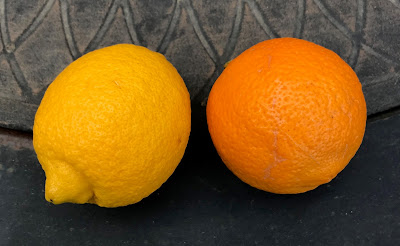Today I found a variety of ripe, or almost ripe citrus fruits in the yard. I'll describe here my tasting results on some oranges, mandarins, grapefruits, and lemons. The pictures and tasting are all from December 31, 2017.
They are pretty sour and juicy. I assume they are ripe. The unknown has thinner peal, but does not pass for Meyer, as it is too sour.
I'm planning to re-taste many of these in mid-January again.
Navels and Tangor
Left to right: Early Navel, Washington Navel, and Kiyomi Tangor
All these are ripe, but Kiyomi Tangor may benefit from couple weeks more on the tree. This tangor is the most juicy and the least sweet out of these. Washington Navel has the most complex flavor, but I should note that it comes from the oldest (out of these three) graft.
Pigmented oranges
Left to right: Moro blood orange, Boukhobza blood orange, and Vaniglia Sanguino.
Moro needs a week or two more on the tree, Boukhobza is pretty good already, but should be even better and more colorful in couple of weeks. Vaniglia Sanguino is sweet and juicy, and I suspect it is at the peak of flavor now. It is an acid-less orange.
Mandarins
Left to right: USDA 6-15-150, Daisy SL, Page, and Algerian Clementine
All four varieties are fully ripe now. Daisy SL is my favorite. Page and USDA 6-15-150 are pretty good too. Algerian Clementine is the most acidic, but has a nice complex flavor. It's also very juicy, along with the USDA 6-15-150.
Grapefruits
Red and Cocktail.
The Red is not ready, may need 3-4 more weeks on the tree. The Cocktail is perfect, very juicy and sweet.
Lemons
Lisbon (left) and my unknown lemon.
I'm planning to re-taste many of these in mid-January again.












































